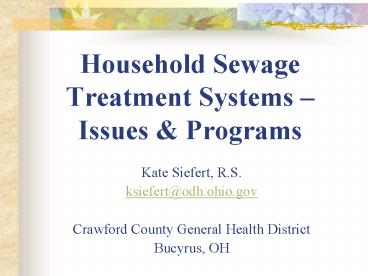Household Sewage Treatment Systems Issues - PowerPoint PPT Presentation
1 / 23
Title:
Household Sewage Treatment Systems Issues
Description:
Every day, it is estimated that the people on Earth produce 11 billion pounds of ... A two-seater outhouse one side with carpet? (not exactly) ... – PowerPoint PPT presentation
Number of Views:32
Avg rating:3.0/5.0
Title: Household Sewage Treatment Systems Issues
1
Household Sewage Treatment Systems Issues
Programs
- Kate Siefert, R.S.
- ksiefert_at_odh.ohio.gov
- Crawford County General Health District
- Bucyrus, OH
2
- Every day, it is estimated that the people on
Earth produce 11 billion pounds of sewage.
(Every day!)
3
The average Ohio household produces 360 gallons
of wastewater per day (2,520 gal/week 131,040
gal/year).
4
What is a Household Sewage Treatment System
(HSTS)?
5
- A two-seater outhouse one side with carpet?
- (not exactly)
6
And every Health inspectors favorite quote from
a homeowner - But my house is Grandfathered!?!
- A common misconception, homeowners often feel
that since they live in an older home, their
sewage somehow doesnt pollute regardless of
whether or not they have a septic system.
7
Types of HSTS
- Discharging systems aeration tanks, subsurface
sand filter beds, upflow filters - On lot systems leach fields, mound systems,
peat bio-filter systems, drip distribution
systems
8
Discharging Systems Key Issues
- Ohio has been in violation of National EPA
standards for discharges from home septic systems
for many years - Homeowners often neglect the necessary
maintenance needed to properly treat the
discharging wastewater - Often associated with small lots in concentrated
areas (small villages)
9
Key Issues for On Lot Systems Unsuitable sites
soils
- Long history of leaching trenches in saturated
soils dilution versus treatment
10
Treatment in Soil
Nutrients
TSS
BOD
Unsaturated aerobic zone
Bacteria
Viruses
Nutrients
Limiting condition of perched seasonal high water
table
11
And now, new to 2006the biggest change in Ohios
sewage history.
- the passing of HB 231
12
Adoption of New Sewage Treatment System Rules (HB
231) May 4, 2006OAC, Chapter 3701-29
- Prior to HB 231, the household sewage treatment
program was the only ODH environmental health
program without a specific governing statute. - The ODH household sewage system rules have not
been updated since 1977 and over a quarter
century much has changed.
13
What does this mean for future installations of
septic systems?
- Very detailed site evaluations requiring a
minimum of 2 feet of suitable soil prior to a
limiting condition (seasonal ground water,
bedrock, etc.) - This means most systems will have pre-treatment
or have to be a mound type system. - Homeowners will most likely need an evaluation
from a soil scientist prior to Health Dept.
approval.
14
- All installations will have to be re-inspected
within 18 months of installation by the health
dept. - All septic systems will be required to have an
Operation Maintenance Permit. - Rules will significantly limit the use of
discharging systems (no discharging systems for
newly constructed lots) - Replacement systems that discharge off lot are
required to obtain an NPDES permit through OEPA - Yearly testing required for all discharging
systems
15
Household Septic System Replacement Program in
the Sandusky River Watershed
- Cost Share funding by the Ohio EPA working in
conjunction with your local health department.
16
Overview of the 319 Grant
- The goal is a replacement of at least 170
household sewage treatment systems in 9 target
areas of Crawford, Erie, Sandusky, Seneca
Wyandot counties with a total of 740,000 federal
monies. - Reduction of over 29 million gallons of
untreated sewage discharged into surface and
ground waters of the Sandusky River Watershed
annually.
17
Water samples taken by OEPA from tributaries of
the Upper Sandusky River in Crawford County
prior to replacing any septic systems
18
Criteria for Participants
- Homes with failing systems in the target areas.
Or - Homes with no record of a household sewage
treatment system in the target areas. Or - Homes with an older discharging system that
choose to upgrade to an on-lot system.
19
Cost ShareAvailable
- 50!
- Up to 4,000 for septic tank and conventional
leaching field systems - Up to 6,000 for alternative/experimental systems
- Additional Assistance (up to 75) for Low-Income
Applicants - Low Interest Loans available at United Bank
(Crawford County) Republic Banking Company
(Seneca County).
20
Conventional System(2 compartment tank,
distribution box, leaching tile field)
Cost Share Available up to 4,000
21
Experimental/Alternative Systems
Cost Share up to 6,000
Aeration Tank Leach field
Finished Landscaped Peat Biofilter System
Drawing Schematics of a Mound System
22
OEPA S.319 Success Stories!
To date, 72 approved applications for replacing
their septic systems!
This home used to discharge directly to a
tributary of the Sandusky River toilet paper
and all!
23
Thank you!
- Questions?

